Soldier's Monument
Introduction
Text-to-speech Audio
The Soldiers’ Monument was the brainchild of the Richard Wallace Circle No. 12 Ladies Auxiliary of the Grand Army of the Republic (G.A.R.). In March 1907, the ladies decided to fundraise for the construction of a granite statue in memory of those who served in the U.S. military from 1776-1907, and ultimately, hoped this would serve as daily lesson in patriotism for Clarksburg’s citizens. The cost amounted to $2,000.
However, the campaign the group created faced challenges. The monument fund found many financial supporters during the first two months of the drive. But, donations came to a stand-still by the end of April 1907 with a remainder of $1,431 for the cost of the statue and dedication ceremony. As the fundraising campaign dragged on into the summer, the ceremony was pushed to August and then permanently set for May 30, 1908.
By the time May 30 dedication arrived, the Soldiers Monument had lived under a canvas tarp on the east corner of the courthouse yard since its placement in October 1907.
But, this is not the end of the monument’s story. The Soldiers Monument traveled three times since its placement on the courthouse square in 1908. At one time or another, the statue lived near the old City Hall at the former Mortimer Smith House on West Main Street; the Nathan Goff National Guard Armory, and finally in front of newest City Building on West Main Street where he remains to this day.
Images
Photo of the Solider's Statue in front of the old Harrison County Court House. Courtesy of the Harrison County VW Historical Society
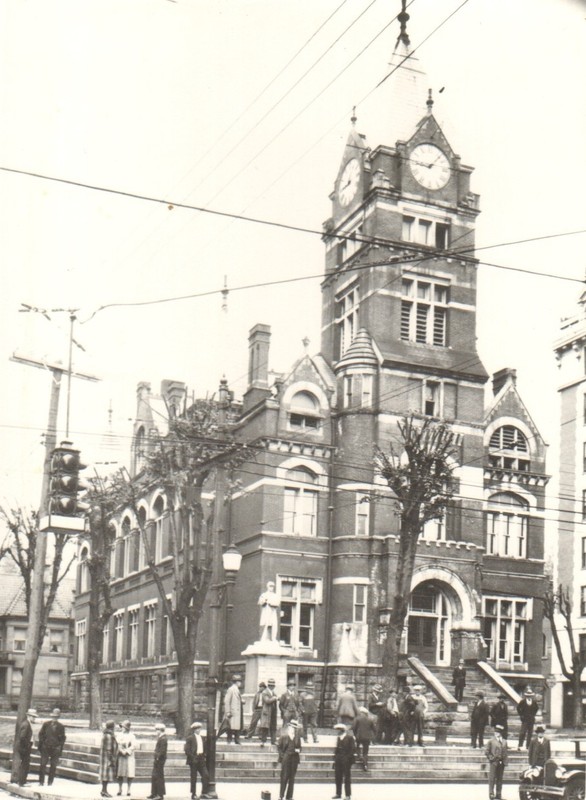
Photo of the dedication of the statue of the Solider's Monument outside the Harrison County Court House. Courtesy of the Harrison County VW Historical Society
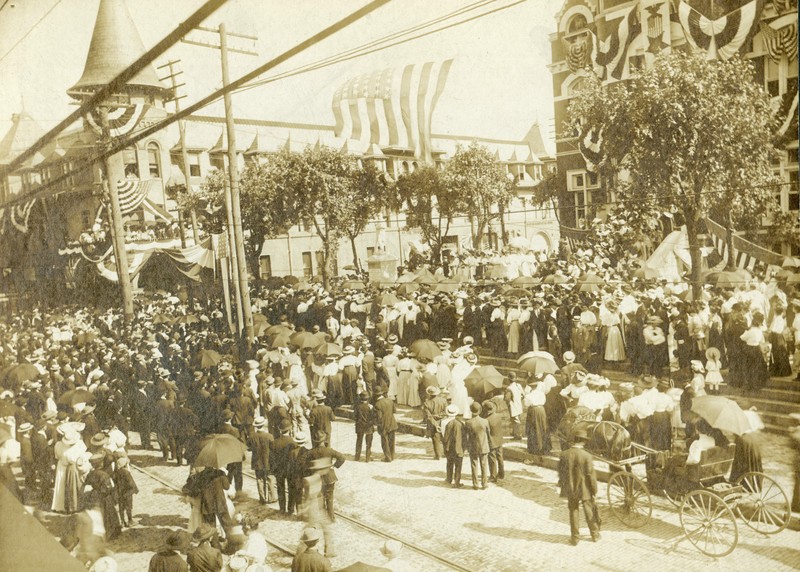
Newspaper Clipping of the dedication of the Soldier's Statue.
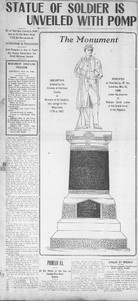
Photo of boys at the foot of the Statue in 1911. Courtesy of the West Virginia Reginal History Center.
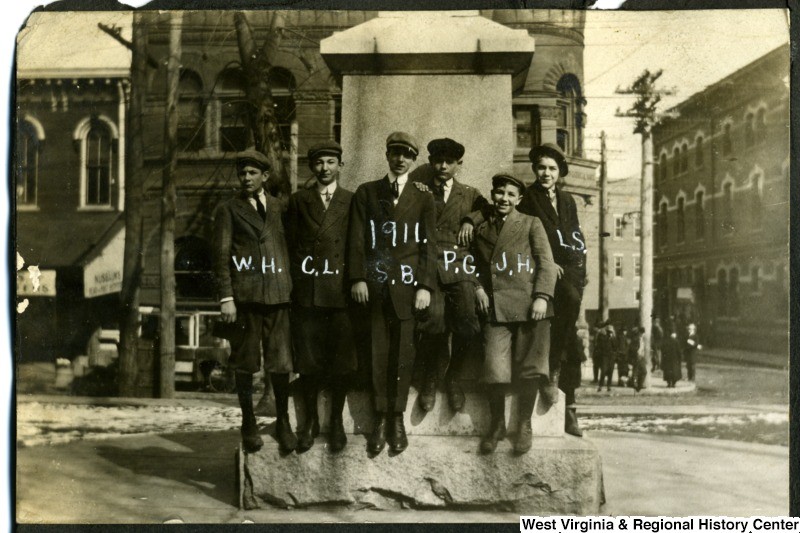
Photo of the statue at its current location outside the Clarksburg City Building.
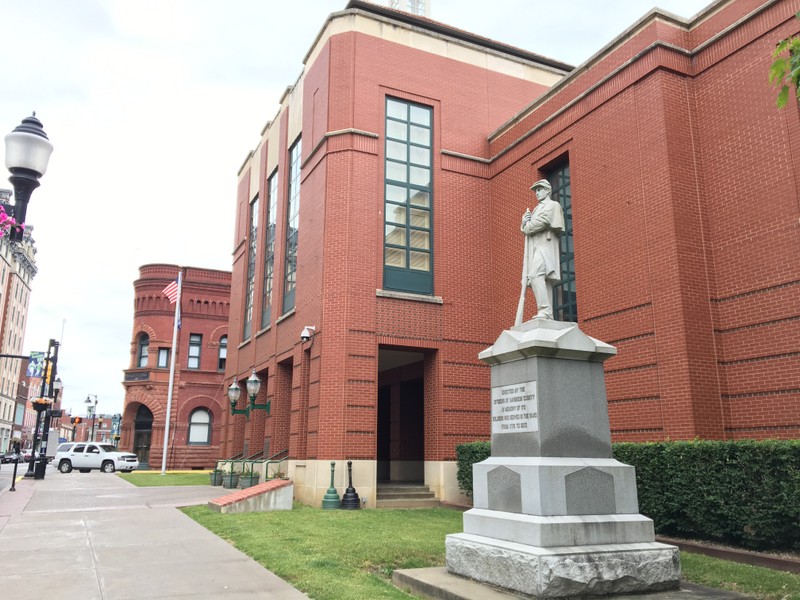
Photo of the statue at the Nathan Goff National Guard Armory. Courtesy of the West Virginia Reginal History Center.
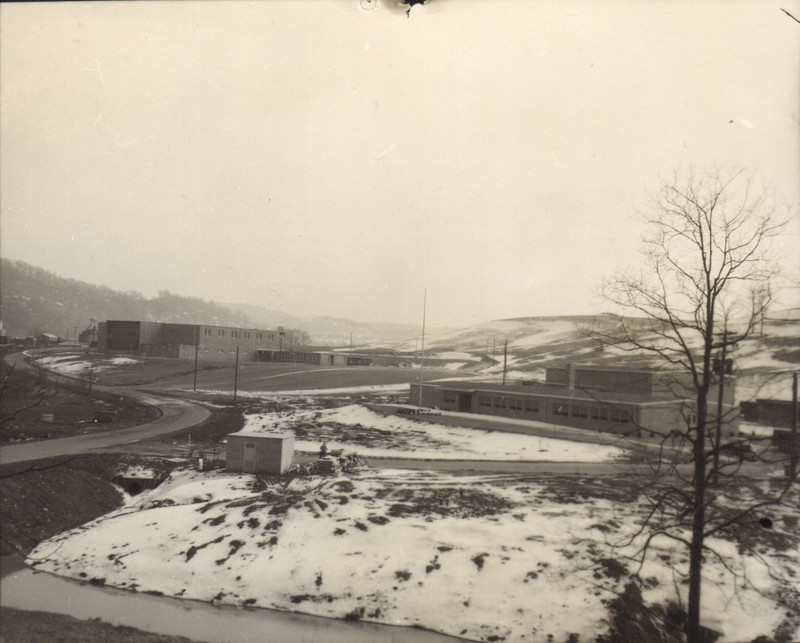
Backstory and Context
Text-to-speech Audio
The Soldiers’ Monument was the brainchild of the Richard Wallace Circle No. 12 Ladies Auxiliary of the Grand Army of the Republic (G.A.R.). In March 1907, the ladies decided to fundraise for the construction of a granite statue in memory of those who served in the U.S. military from 1776-1907, and ultimately, hoped this would serve as a daily lesson in patriotism for Clarksburg’s citizens. The G.A.R. ladies chose local marble and granite dealer, Elmore W. Wells, for the design and construction of the monument. The cost of creating such a substantial patriotic emblem amounted to $2,000 which equals approximately $49,000 in today’s money. With publicity assistance from the editors of The Clarksburg Telegram, the Wallace Circle No. 12 led the charge for monument’s fundraising campaign.
However, the campaign faced challenges. The monument fund found many financial supporters during the first two months of the drive. But, donations came to a stand-still by the end of April 1907 with a remainder of $1,431 for the cost of the statue and dedication ceremony. The slowdown of funds also contributed to the dedication ceremony’s many reschedules. The G.A.R. ladies originally planned for a July 4 dedication ceremony with Judge Nathan Goff, Jr. as the keynote speaker. As the fundraising campaign dragged on into the summer, the ceremony was pushed to August and then permanently set for May 30, 1908.
Despite the setbacks, the Soldiers Monument and its unveiling ceremony truly became the community affair. More than 170 organizations, businesses, and individuals of all income levels donated to the fund. The G.A.R. ladies alone contributed $100, and other donations ranged from 0.25¢ to $200. Additionally, the community answered the call when it came time to organize the unveiling. Captain Duncan Boughner and Colonel C. A. Osborn of Company K of the WV National Guard, Charles W. Worcester, and the G.A.R. ladies selected a military feature for the dedication day which included a parade and roster of speakers. Lawson & Todd of Pittsburgh, PA was selected to deck the courthouse square with patriotic bunting, and Clarksburg’s oldest citizen at 99 years, Colonel Luther Haymond, was nominated for the privilege of unveiling the monument.
By the time May 30 dedication arrived, the Soldiers Monument had lived under a canvas tarp on the east corner of the courthouse yard since its placement in October 1907. The grand parade featuring the Co. K of the WV National Guard, Northview and Tinplate Royal Italian bands, G.A.R. ladies, Clarksburg police and fire department, and various fraternal organizations was delayed an hour from its 1:00 p.m. start time due to rain. But the clouds cleared, and the unveiling proceeded on schedule. James E. Law, Sr.; Millard F. Snider; Anna Hall, ex-president of the national chapter of the Ladies G.A.R.; and keynote speaker, Rev. Dr. Elmer E. Higley, minister of the First Methodist Church in New Castle, PA, all made patriotic addresses during the ceremony. The event ended with a musical performance by the Clarksburg High School chorus. By 5:00 p.m., the hundreds in the crowd returned home and the Soldiers Monument began his watch over Clarksburg.
But, this is not the end of the monument’s story. The Soldiers Monument traveled three times since its placement on the courthouse square in 1908. The statue was moved to the old City Hall at the former Mortimer Smith House, on West Main Street in 1953 to make room for they General Thomas “Stonewall” Jackson statue. It was then moved at some point to the Nathan Goff National Guard Armory, and finally in front of newest City Building on West Main Street where he remains to this day.
Sources
Davis, Dorothy. History of Harrison County West Virginia. Clarksburg, West Virgina. American Association of University Women, 1970. Clarksburg
"Solider's Fund Growing Fast." Clarksburg Telegram (Clarksburg), May 02, 1907.
"Statue of Solider Unveiled With Pomp." Clarksburg Daily Telegram (Clarksburg), May 30, 1908.
"Solider's Fund Growing Fast." Clarksburg Telegram (Clarksburg), May 02, 1907.
"Statue of Solider Unveiled With Pomp." Clarksburg Daily Telegram (Clarksburg), May 30, 1908.
